
Crimea is a peninsula in Eastern Europe, on the northern coast of the Black Sea, almost entirely surrounded by the Black Sea and the smaller Sea of Azov. The Isthmus of Perekop connects the peninsula to Kherson Oblast in mainland Ukraine. To the east, the Crimean Bridge, constructed in 2018, spans the Strait of Kerch, linking the peninsula with Krasnodar Krai in Russia. The Arabat Spit, located to the northeast, is a narrow strip of land that separates the Syvash lagoons from the Sea of Azov. Across the Black Sea to the west lies Romania and to the south is Turkey. The largest city is Sevastopol. The region has a population of 2.4 million, and has been under Russian occupation since 2014.

The Dnieper, also called Dnipro or Dniapro, is one of the major transboundary rivers of Europe, rising in the Valdai Hills near Smolensk, Russia, before flowing through Belarus and Ukraine to the Black Sea. Approximately 2,200 km (1,400 mi) long, with a drainage basin of 504,000 square kilometres (195,000 sq mi), it is the longest river of Ukraine and Belarus and the fourth-longest river in Europe, after the Volga, Danube, and Ural rivers.
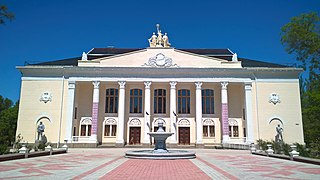
Nova Kakhovka is a city in Kakhovka Raion, Kherson Oblast, southern Ukraine. Nova Kakhovka has been under Russian occupation since February 2022. Its estimated population in 2022 was 44,427.
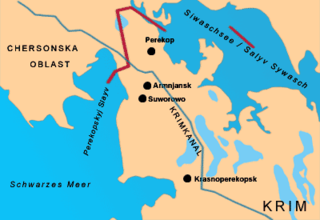
The Isthmus of Perekop, literally Isthmus of the Trench, is the narrow, 5–7 kilometres (3.1–4.3 mi) wide strip of land that connects the Crimean Peninsula to the mainland of Ukraine. The isthmus projects between the Black Sea to the west and the Syvash to the east. The isthmus takes its name of "Perekop" from the Tatar fortress of Or Qapi.

Kherson Oblast, also known as Khersonshchyna, is an oblast (province) in southern Ukraine. It is located just north of Crimea. Its administrative center is Kherson, on the northern or right bank of the Dnieper river, which bisects the oblast. The oblast has an area of 28,461 km2 and a population of 1,001,598. It is considered the 'fruit basket' of the country, as much of its agricultural production is dispersed throughout the country, with production peaking during the summer months.
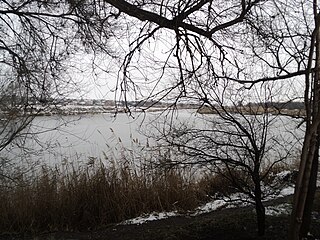
The Konka, also known as the Kinka, Kinska, or Kinski Vody is a left tributary of the Dnieper, flowing through Zaporizhzhia Oblast, Ukraine. It is 146 km (91 mi) long, and has a drainage basin of 2,580 km2 (1,000 sq mi). It originates in the Azov Upland and flows into the Kakhovka Reservoir on the Dnieper. The cities of Polohy and Orikhiv are located on the river.

The Kakhovka Reservoir was a water reservoir on the Dnieper River in Ukraine. It was created in 1956 by construction of the Kakhovka Dam at Nova Kakhovka. It was one of several reservoirs in the Dnieper reservoir cascade.

The Dnieper reservoir cascade or Dnieper cascade of hydroelectric power stations is a series of dams, reservoirs and hydroelectric power stations on the Dnieper river in Ukraine. It was created to prevent uncontrolled flooding and improve water transportation infrastructure. Coordination and operation of all dams on the Dnieper is conducted by government company Ukrhydroenergo. In 1970, the Kyiv dam partially prevented flooding in comparison with the 1931 Kyiv flooding.
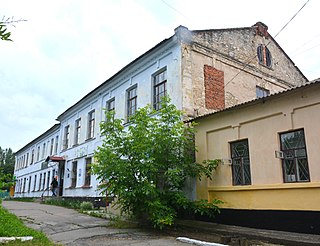
Kakhovka is a port city on the Dnieper River in Kakhovka Raion, Kherson Oblast, of southern Ukraine. It hosts the administration of the Kakhovka urban hromada, one of the hromadas of Ukraine. It had a population of 34,749.

The Inhulets or Ingulets is a river, a right tributary of the Dnieper, that flows through Ukraine. It has a length of 557 kilometres (346 mi) and a drainage basin of 14,460 square kilometres (5,580 sq mi).

Oleshky, previously known as Tsiurupynsk from 1928 to 2016, is a city in Kherson Raion, Kherson Oblast, southern Ukraine, located on the left bank of the Dnieper River with the town of Solontsi to the south. It is the oldest city of the oblast and one of the oldest in southern Ukraine. It is known for its proximity to the Oleshky Sands, a large desert region. Oleshky is the site of artist Polina Rayko's home, a national cultural monument of Ukraine. It also hosts the administration of Oleshky urban hromada, one of the hromadas of Ukraine. It had a population of 24,124.
Tavriisk is a small city in Kakhovka Raion, Kherson Oblast, southern Ukraine, close to the city of Nova Kakhovka. It is located on the left bank of the Dnieper River. Tavriisk hosts the administration of the Tavriisk urban hromada, one of the hromadas of Ukraine. It has a population of 10,108.
Canals in Ukraine are mostly for irrigation or water supply. Most of them are supervised by the Canal Administration of the State Agency of water resources of Ukraine. As the rest of water resources canals compose the Water Fund of Ukraine and are included in the Water Cadastre (register) of Ukraine.

The Kakhovka Dam was a dam on the Dnieper River in Kherson Oblast, Ukraine, completed in 1956 and destroyed in 2023, which provided water for the Kakhovka Hydroelectric Station. The primary purposes of the dam were hydroelectric power generation, irrigation, and navigation. It was the sixth and last dam in the Dnieper reservoir cascade.

The Republic of Crimea is a republic of Russia, comprising most of the Crimean Peninsula, but excluding Sevastopol. Its territory corresponds to the Autonomous Republic of Crimea, a subdivision of Ukraine. Russia occupied and annexed the peninsula in 2014, although the annexation remains internationally unrecognized.
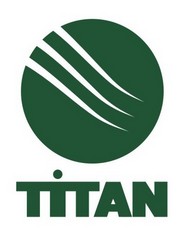
Crimea TITAN is the largest manufacturer of titanium dioxide pigment in Eastern Europe. It is located in Armyansk, Crimea.
The Rohachyk river is a left tributary of the Dnieper river in Kherson oblast, Ukraine. It has a length of 41 km. The river valley is up to 200 m wide. The width is generally 5 m. There are several ponds on the river. It names derives from a Ukrainian word for the "horn" as the river is winding.
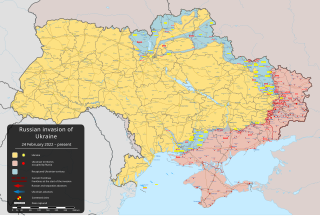
The southern Ukraine campaign is an ongoing theatre of operation in the Russian invasion of Ukraine, which began on 24 February 2022. From their base in Russian-occupied Crimea, the Russian Armed Forces attacked Kherson Oblast, Mykolaiv Oblast, and Zaporizhzhia Oblast in southern Ukraine, battling the Armed Forces of Ukraine.

Nova Kakhovka River Port is in Tavriisk, a town on the eastern side of Nova Kakhovka, in Kherson Oblast, Ukraine. The port is on the left bank of the Dnipro river, at the south-western end of the Kakhovka Reservoir, adjacent to Kakhovka Dam. The port is in a basin at the upstream end of the shipping lock that passes through the dam. The port opened in 1962.

The Kakhovka Dam in Ukraine was breached in the early hours of 6 June 2023, causing extensive flooding along the lower Dnieper river, also called the Dnipro, in Kherson Oblast. The dam was under the control of the Russian military, which had seized it in the early days of the Russian invasion of Ukraine. Many experts have concluded that Russian forces likely blew up a segment of the dam to hinder the planned Ukrainian counter-offensive. Russian authorities have denied the accusation.

























